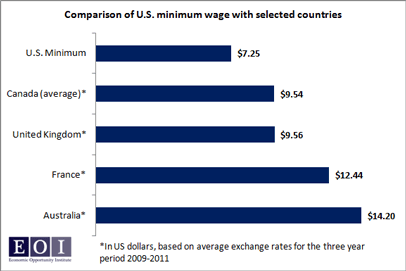 Washington state grabbed headlines this year with a minimum wage of $9.04/hour, thanks to a voter-approved automatic cost-of-living adjustment enacted in 1998. In 32 other states, the federal minimum – just $7.25/hour – applies.* But if it were adjusted for inflation using the Consumer Price Index (CPI), the federal minimum would be $9.16 today.
Washington state grabbed headlines this year with a minimum wage of $9.04/hour, thanks to a voter-approved automatic cost-of-living adjustment enacted in 1998. In 32 other states, the federal minimum – just $7.25/hour – applies.* But if it were adjusted for inflation using the Consumer Price Index (CPI), the federal minimum would be $9.16 today.
For America’s economy to function well over the long run, wages have to keep up – at the very least – with the cost of living. But inflation isn’t the only way to measure how well wages are keeping up with the economy, according to Salvatore Babones:
…the Social Security Administration uses something called the Average Wage Index (AWI)…[which is] an index of the average wages paid in any given year…[because] the CPI adjusts for changes in the cost of living, but doesn’t adjust for changes in quality of life. Simply put, we expect people to live better in 2012 than they did in 1974.
Adjusted for wage growth using the Average Wage Index (AWI) [the federal minimum wage] would be $10.74.
That said, even wage growth doesn’t tell the whole story, because wages have not kept pace with rising economic prosperity in America. Here’s Babones again:
Since the 1970s ordinary workers’ wages have failed to rise along with the economy as a whole. The massive rise in non-wage income (dividends, interest, and capital gains) has made workers’ wages a smaller and smaller slice of the overall pie. America’s total personal income per capita – including income from all sources – has risen much faster than the Social Security AWI.
Between 1974 and 2011 the AWI rose a cumulative 17 percent (adjusted for inflation). Per capita personal income (PPI), on the other hand, rose 57 percent (adjusted for inflation). Had the minimum wage been indexed to PPI growth starting in 1974, the minimum wage today would be $14.41 an hour. That’s a far cry from $7.25.
And finally, to put this in international perspective, Babones calculates that based on average exchange rates for the three year period 2009-2011:
In Canada, the minimum wage is between USD $8.59 and $10.50. In the United Kingdom, the minimum wage is about USD $9.56. In France, it’s about USD $12.44. In Australia, the statutory minimum is about USD $14.20, but very few workers earn so little. The standard wage for fast food and other service jobs is…about USD $15.59.
*Note: Eighteen U.S. states have a minimum wage set higher than the federal standard.
More To Read
April 17, 2024
2023-24 Impact and Gratitude Report
Reflecting on a year of progress and transition at EOI
April 12, 2024
Welcoming our New Executive Director, Rian Watt!
EOI is excited to begin its next chapter under new leadership
April 4, 2024
Is There a Valid Argument Against Cost-Free College in Washington?
Cost-free college is a meaningful investment that would change lives. What's stopping Washington from making it happen?

